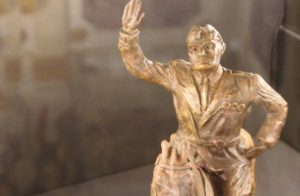This statuette was commissioned in the mid-1930s to glorify ‘il Duce’. It’s about 18 inches tall, but it carries a story much taller than that…
The artist and sculptor Antonio Ligabue (1899-1965) was not what anyone who knew him would have called a ‘people person’. Though obviously talented – albeit in that self-taught way art experts refer to as ‘naïve’ – he didn’t often endear himself to those who lived around him. If he were alive today they would probably by now have found somebody qualified to say that he was ‘on the autistic spectrum’. In the mid-20th century, however, he was generally considered to be just a weirdo (not to put too fine a point on it).
He would be seen riding his scooter around his home town of Gualtieri, and perhaps to the neighbouring villages, often with a canvas attached to his back that he was transporting to who knew where. Then he would return, always alone, to his studio, to scratch and scrape through the night like a tormented mouse, completely absorbed in work which many people at the time were not convinced was altogether very good.
He was, however, famous enough to come to the attention of the authorities – who were of course at that time Fascist. A friend of his (and he didn’t have many) was sent by Rome to order from him a statue of Mussolini, one that would show il Duce in a fine light. The work, his friend informed him, was to be begun immediately and completed as soon as possible. With the commission delivered, his friend donned his hat and left.
Ligabue scratched his head. And then his chin. He was not known for being a man of politics, Fascist or otherwise, but more significantly he was not a man who could work to order. He would complete the sculpture – of course he would – but he wouldn’t start on it today. Not just yet. The muse would surely come, and when it did he would begin. He returned to his studio to continue work on his other projects.
The muse, of course, didn’t appear, and when his friend returned, some months later, the news that Ligabue has done precisely no work on the statue was greeted with some disappointment. He must understand: this was no ordinary commission; this was from Mussolini; this job was not an option; it was an order! His friend would return in a few weeks to collect the statue. Ligabue went back to his studio to resume his work, again, on his other, personal projects.
It continued like this. His friend returned at periodical intervals; Ligabue would have nothing to show. The pressure from Rome was mounting. Eventually, his friend decided that he would have to stay in Gualtieri while the artist made the statue. Ligabue knocked it out in a morning. But he made a mistake: the right hand, which should have the palm facing forwards in the Fascist salute, had the palm facing backwards – which in Italy means something very different…
“Well I haven’t had my lunch yet,” was Ligabue’s excuse. “It’s difficult for me to work under pressure like this on just a light breakfast.” His friend was obliged to stump up for a trip to the local trattoria before they returned to the artist’s workshop, where Ligabue cheerfully broke off the hand and refixed it backwards. Or forwards, depending on which way you look at it.

